Posted on 30 November 2022
Te Au o Te Moana - Voice of the Ocean: John Reid
- News
- Blue economy Kaitiakitanga Land-sea interaction Marine values Tikanga and mātauranga Māori Blue economy Phase II (2019-2024)
- 15 Minutes to read
“As much as we can be Kaitiaki, different species can be kaitiaki, or the ocean itself can be kaitiaki. It's this interconnected relationship. That's what drives me, both that sense of care in the relationship and also a sense of being cared for in that relationship. The underlying impetus or motive for the work is how do we establish that balance in the relationship, or how do you tauutuutu”.
Published November 2022
Interview by Desna Whaanga-Schollum (DWS)
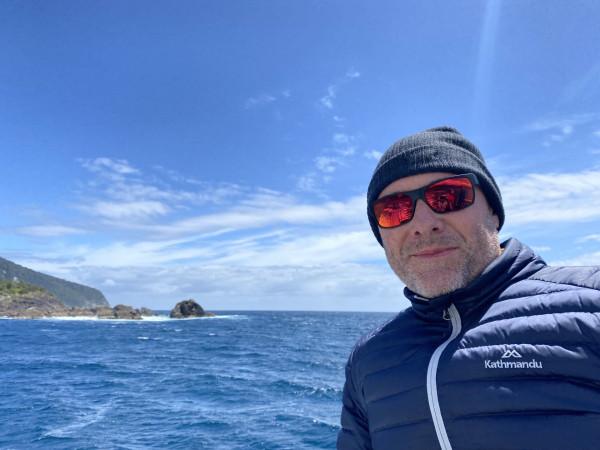
John Reid, Te Wai Pounamu, 2022
Ko Matawhaura tōku Maunga
Ko Kaituna tōku awa
Ko Ngāti Pikiao tōku iwi.
Ko Te Arawa tōku Waka,
Tena Koutou Katoa,
Ko John Reid tōku ingoa.
The Māori side of the whānau is originally from Rotoiti, and our marae is Tapuwaeharuru, up in the North Island, although I've been living for nearly 30 years in Ōtautahi, Christchurch. I'm based at the Ngāi Tahu Centre at the University of Canterbury, and I also work as an independent consultant. My undergraduate work was in Agroecology and Forestry. Then I went on to do a PhD on sustainability on Māori land, looking at different development options. Those case studies were stretched right across the country.
I was the Ngāi Tahu Regional Development Manager for four years while I was finishing my PhD. I then moved to the Ngāi Tahu Research Centre, where I focused on land and sea sustainability issues, covering forestry, agriculture and fisheries sectors.
What piqued your interest in Sustainable Seas?
Māori have nearly 22% of the quota by value and nearly 35% of the quota nationally, growing at two or 3% per year. You just need to add that up to understand that in the next few decades, Māori will own New Zealand fisheries.
The economic side of things for Māori is an area that's often neglected in research. It’s usually working at community levels, but not much is done on the commercial scale where a many iwi are heavily involved. They're huge players in the area and often run corporate models. So the question is, how do you infuse Māori thinking into those corporate models?
Also, the assets are held by large centralised authorities within corporate vehicles. Frequently the [Treaty] Settlement process itself has alienated Māori fishing villages, whānau fishing enterprises and communities. They’re relegated to a cultural space where Māori have cultural harvest rights under that part of the system. But the problem is that there is a separation between the two. So, I am also interested in how we could use centralised assets to rebuild Māori fishing communities.
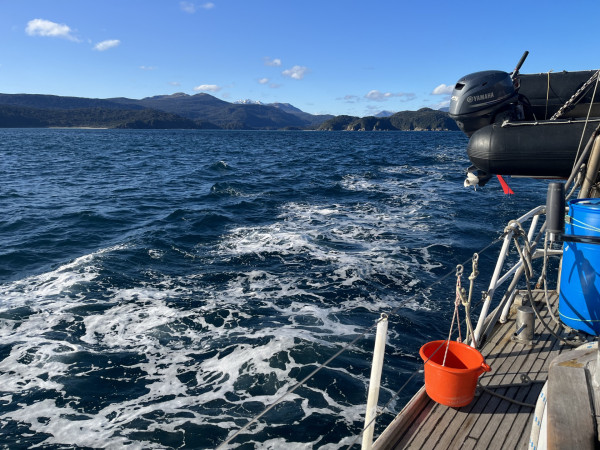
Rakituma, Ngāi Tahu territory. Photo credit DWS
How do you feel connected to the moana?
One of those connected moments when I was about seven or eight, I was sitting on the beach on my own in the evening, just as the sun's going down, a perfectly fine day in summer. I had this this overwhelming feeling where I felt like I belonged, and you know, no concerns, nothing. I was just there with those waves slapping up... almost like a state of bliss. I don't know if that counts as a type of connection, almost a feeling. I remember saying to myself - Oh, the sea is like my Mother, and I don't know where that came from. But yeah, this powerful sense, of just being in the zone.
Although our Māori side of our family links are in Rotoiti, I grew up in Auckland and largely on the beach. I was fishing in the morning before school, so I had a pretty once-upon-a-time childhood… when you could catch snapper off the beach. I had a strong connection there.
My whānau also spent a lot of time in the far North with my grandfather on the Hokianga. Although he was Ngāti Pikiao, he moved up north with my grandmother when he remarried, she was Ngā Puhi. They had a place where they lived subsistently, or pretty close to, for many years. Down the bottom of their farm / native forest area was a beach right on the Hokianga Harbour. That's where I learnt everything about Mahinga Kai and fishing. Spending my summers there I'd be putting nets out and spending days, filleting, preserving, all that sort of stuff. I also spent a lot of time surfing on the Coromandel. I learned about how to live that lifestyle and a deep connection to the Moana.
I’ve had a strong sense from a young age, and certainly over my lifetime, of fisheries deteriorating. Visibly deteriorating.
Knowing what it was like when I was young, compared to what my grandfather would say when he was young, he could pull out of the water. Comparing what we could a few years ago - to now. I know it's anecdotal, but those stories are important for giving us a baseline for thinking about changes. That was really my relationship.
It was funny moving down here to the South Island, to go from one environment to another. I didn't know how to fish down here at all. How the tides worked, what the different fish species were, and where to be. It was funny being in one place where you know when things run, when you know what time of a tide, all those sorts of things. Then you come down here, and it's a completely different scenario. That's a thing that stood out to me, how connected you get to a place and then when you're taken to another place, how disconnected you can be. Certainly, in terms of the Moana in that sense.
It was much less abundant than what I was used to up North. Also, talking locally here with kaumātua and them noting how a lot of the fisheries are declining significantly down this way too.
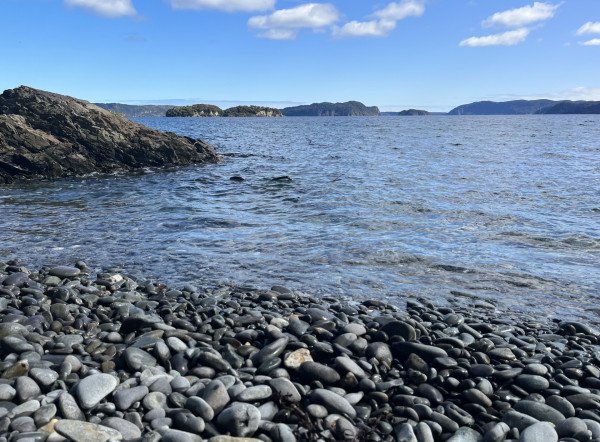
Tamatea – Waka Wānaka, Te Waipounamu, 2022. Photo credit DWS
What motivates you to work for better moana management?
From a young age, I'd see land in a degraded state I've had a powerful feeling and intuition that it needs caring for. That it's not being cared for. That it's an abusive relationship. That's how I understand it as if it's been turned into some - thing - a resource that is used for your own means as opposed to having a relationship with it. It's taking all of the spiritual qualities out of the relationship. That's how it's felt.
While we use things as a resource, it doesn't necessarily need to take away that deep connection that we have. See, kaitiakitanga is an interesting term because it often gets translated poorly into English as stewardship or guardianship. As if you were the one in control of the relationship. Whereas I think kaitiakitanga, how I understand it, it's a mutually enhancing relationship.
You care for it, and it cares for you.
As much as we can be Kaitiaki, different species can be kaitiaki, or the ocean itself can be kaitiaki. It's this interconnected relationship. That's what drives me is both that sense of care and the relationship, but also a sense of being cared for in that relationship. The underlying impetus or motive for the work is how do we establish that balance in the relationship, or how do you tauutuutu, how do you enhance that relationship? How do you give and receive, and give and give and give, so it builds up this positive connection and relationship?
Then it boils down to all the technical management things of how you actually relate or manage species. I think it needs to come from the ngakau, what provides the impetus for your motivation and your relationship.
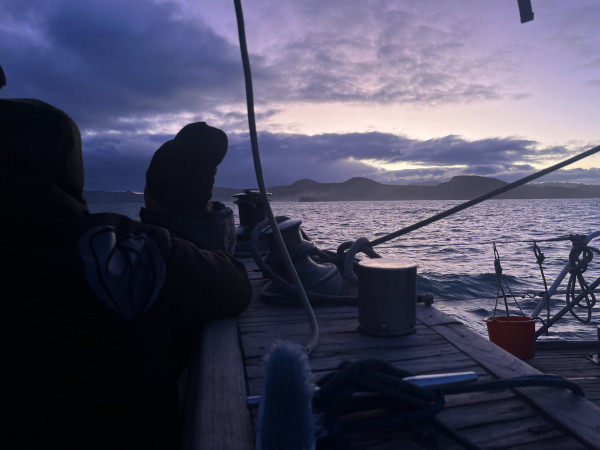
Waka Wānaka, Te Waipounamu, 2022. Photo credit DWS
How would you describe the current set of moana now in Aotearoa?
We've got a lot to be proud of in what New Zealand is doing. If we look at it in comparison to other countries or internationally, what we're attempting to do here is pretty good. There's a lot of criticism of the quota management system, but we have to look at it with the counterfactual - Well, what else would you use? Or what's happening in other places? And there are some other examples which might be good—coming first of all, from that positive perspective of what we're attempting to do.
But what we are missing here is the land-sea interface. It's how we're treating the whenua that's having an impact on the oceans the most. From that perspective, it's land management where I put my effort. The flow-on effects of land management, the sediments and nutrients end up in our wetlands and our coastal marine areas. There's a whole bunch of solutions to what we're doing on our land that we already know work and can have a massive impact that don't disrupt our living standards. When we think about economic development, that could make a massive change now. The investments are there, and resources and capital are there to make these shifts and changes. So that's, to me, the frustration.
The issue is knowledge and how knowledge goes out. Then how knowledge is up taken and how transformation occurs through that. Often we are blocked by ideologies on that front. Then on the ocean front – we are seeing a decline, generally, both anecdotally and from a scientific perspective, because we don't know enough about how these systems operate to manage them effectively.
There are practical things we can do, drawing on Māori approaches. For example, there could be large sections of our marine state in rāhui, or highly protected states, given that they act as seeding mechanisms for the rest of the system.
Take Goat Island Marine Reserve, 10% of all snapper in the Hauraki Gulf originate there. I mean, that's under 10 square kilometres! It's a tiny area, but it's seeding that whole Gulf. So I think we can improve the vibrancy of the fisheries through these reserve areas, rāhui, and better management mechanisms. Locking-up places allows them to heal and act as seeding mechanisms for the rest of the marine estate.
On the nuances and complexity of Te Ao Māori thinking…
In the traditional systems for Māori around managing fisheries assets, there'd be seasonal fishing rights orientated around a whole range of things like migration, and patterns of fish. One whānau had a particular right to gather here, at this time of year, for this species, but they wouldn't have it another time of year. The whole system was geared toward seasons, even the technology. You apply one technology here as a hapū to harvest this type of fish at this time of year, but you don't use it at another time of year.
It was a system of property rights and management that was all related, including maramataka and seasonal migration patterns, which are far more nuanced and complex and less blunt than the quota management system, where you harvest X amount in this time period. There's a lot more room to be drawing on mātauranga Māori for nuance in the property rights system and how things operate.
We need to draw more on that insight. It would help if you had a relational way of knowing and engaging from that position. On the terrestrial side, we need much better land management practices to feed into the process and use those mechanisms like rāhui, for locking up large areas systematically and also taking those off when needed—having a far more flexible approach based on a relational way of knowing and building on mātauranga Māori. Which then runs against a whole lot of issues around who currently has property rights in the marine estate. I don't think any of that's insurmountable. It's a matter of making what we currently have more nuanced, and shifting to a different pattern of embedded decision-making.
I always go back to history. In the Anglo-Settler States, there are very, very strict boundaries around ownership. It's almost like a - my land, my sovereignty, notion. When you go back to the property rights systems in Europe, many of which still operate, they are user based—using an area at a particular time of year to harvest certain things at certain times, with a mixture of rights. Including the rights to walk across land. Or even how Ngāi Tahu negotiated their settlement, that it would have rights to Mahinga Kai and to wander the land as part of its land sales agreements - which were never honoured. There was obviously this idea that we'd still be able to manage it - this is your portion to do your sheep farming, but we still want to be able to go up the rivers. We still want to be able to go to all these areas and harvest and so forth, which was a far more flexible understanding of land and property rights management.
We're very blunt here, particularly with managing land eco-type to production type and ensuring there's synergy between those. I'm seeing some mixture of those rights systems, which could work with the ocean.
It’s great what we’re doing here, but it’s a bit blunt.
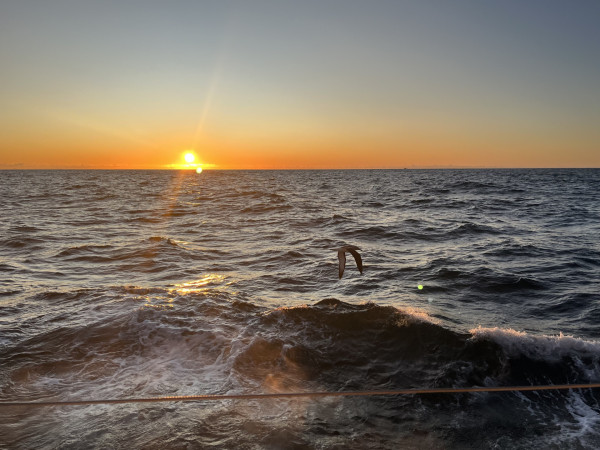
Waka Wānaka, Te Waipounamu, 2022. Photo credit DWS
On institutional structures…
There's a need to rethink how some of the institutional structures have been built. Because of how long that took and how much pain was involved setting all that up - without rocking the boat so much, you tip it over - but enough to be able to revise some of the elements. Such as how Māori could be able to shift quota between each other so that they could get enough critical mass for particular quota species to fish it themselves. As opposed to having to sell the annual catch entitlements, which is currently the case, to act as ACE traders, which is what a lot of iwi have to do. And then how you set-up some of these simple things, around the trading rules, around the annual catch entitlements, falls back into environmental management. How conglomerates of iwi collectives can work in synergy around the management of particular species once they reach a critical threshold of owning so many species within a specific QMA.
There are areas where Māori could be thinking quite strategically, front-footing, and even beginning to write the amendments to particular laws to enable some more fluidity in these areas. I think we're getting some perverse outcomes based on the current structures.
With what we're looking at with our current project, Indigenizing the Blue Economy, we've begun some of the work of reimagining how structures might look, informed by those working and operating in that space, to see what's feasible. We’ll hopefully come up with solutions to some of those issues, hot tips!
What do you think the most significant challenges are in marine management?
Entrenched positions. An emphasis is placed upon ‘what's mine’ and patch protection, property right protection. I was impressed with what Kaikōura Rūnanga did in their takiwa. When they pulled together the whole marine management plan, they brought together all the stakeholders in the area, and they came up with the idea of gifts and gains, which of course, drew from a Te Ao Māori perspective. Everybody was going to throw something in the pot so that everyone could benefit. It took people out of their entrenched positions. As opposed to coming in with a position of gains and losses or something like that, they came with gifts and gains. It totally reframes the way you approach something. Their collective output is for everybody's benefit. The key is the psychology with which these things are approached and overcoming entrenched positions.
Even in regenerative farming, we know that some very different systems are more productive, sequester carbon, soak up nutrients, etc. But trying to get that into the ryegrass, clover, etc. system mindset that's happening across the country, it's hard. People don't shift or change easily. Many people are fearful of change, and they're very conservative. They like the systems they know. They want the institutions they know. So once you start proposing change, it's seen as a threat.
Outstanding models of how things work and how you de-risk that transition to another way of operating can provide important reassurance. Not only to the general public or stakeholder groups, but also iwi, they're very, very conservative too. You have to give them the confidence to make changes that their nest egg, gained through Settlement, isn't going to be taken away if they take some of these risks.
That's the biggest challenge.
Indigenising the blue economy addresses key barriers that currently prevent Māori from using their marine resources in a more culturally relevant, economically impactful, and environmentally sustainable manner. We are partnering with five iwi and pan-iwi entities and Māori enterprises to explore and support Māori who aspire to a blue economy imbued with mātauranga Māori, treaty principles, and a focus on Māori wellbeing, human potential and relational balance with Tangaroa as our tīpuna (ancestor).
View the entire audiogram playlist
Read more in this story series